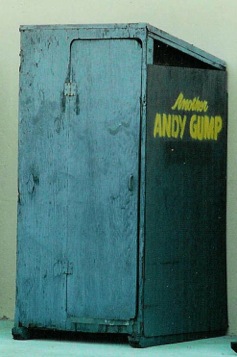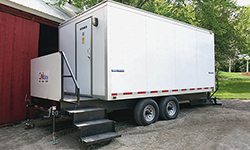Portable restrooms or “porta potties” aren’t usually something you spend a lot of time thinking about. You’ll use these restrooms at special events, parks and on construction sites, but I bet you don’t know a lot about them. Portable restrooms actually have a rich history. There have been several innovations through the past involving portable sanitation that have brought us to the current portable restroom landscape. Let’s take a look at the history of the porta potties, and different innovations the portable restroom industry has made throughout the years.

The Birth of the Porta Potty
 Our story of portable restrooms starts during World War II. This was a time of amazing innovations in the United States including: computers, jet engines, nuclear power and, yes, portable restrooms. These first portable restrooms were invented to take care of ship crews that spent a long time without coming back to shore. They were constructed of wood and metal and were purely utilitarian.
Our story of portable restrooms starts during World War II. This was a time of amazing innovations in the United States including: computers, jet engines, nuclear power and, yes, portable restrooms. These first portable restrooms were invented to take care of ship crews that spent a long time without coming back to shore. They were constructed of wood and metal and were purely utilitarian.
These first portable restrooms were very useful, but didn’t contain most of the “luxuries” that modern portable restrooms have. This was before blue deodorizer was invented, so they were difficult to keep clean and the smell was a major complaint. They also didn’t have hand sanitizer, but hand cleanliness may not have been a top priority for people working on these ships.
Portable restrooms of this time were also very heavy, since they were made of wood and metal. Because of this, they were more difficult to move and empty when they finally did dock. Thankfully, newer and lighter materials were invented in the future.
Invention and Evolution
of Portable Restroom Deodorizer
Portable Restroom Deodorizer or the “blue liquid” in porta potties was invented decades ago and was a huge leap for the portable restroom industry. The first restroom deodorizers were formaldehyde based chemical blends that helped cover up waste, mask bad odors and help keep portable restrooms clean.
Recently the industry has moved to non-formaldehyde based deodorizers since local wastewater treatment plants can’t process them as easily. This new round of deodorizers contains biocides that inhibit the growth of odor-producing gram-positive bacteria. This means they’ll keep the odor causing bacteria from multiplying, which keeps the smell to a minimum. If you would like more information about portable restroom deodorizers you can read our blog “What is the Blue Liquid in Porta Potties”.
The Portable Restroom Renaissance
Around the 1970’s there were a series of portable restroom modernizations that greatly improved the cleanliness, transportation and experience. The first of these inventions were the fiberglass portable restroom. This switched the restroom materials from wood and metal to the lighter fiberglass material. Fiberglass made the porta potties easier to move and clean, but there was a trade off. Fiberglass was a fragile material, which meant the restrooms were prone to breaking. The material also absorbed odors, causing them to capture bad smells and hold onto them.
Shortly after the invention of the fiberglass restroom, the polyethylene portable restroom was first put on the market. In the 1960’s a patent was issued to George Harding, co-founder of PolyJohn Corporation, for a polyethylene portable restroom. These restrooms hit the market in the 1970’s and were much more durable, lighter and easier to move than their fiberglass competitors. These are probably the portable restrooms that you’re used to today. Polyethylene restrooms are more resilient and their useful life can be over 10 years. This allowed for portable restroom providers to expand their fleet and their businesses.
These polyethylene restrooms are also assembled from several different parts, which made it much quicker and cheaper for portable restroom manufacturers to get their restrooms across long distances to local restroom providers. It also made it easier to swap out damaged parts to prolong their useful life.
Luxury Restroom Trailers Hit the Scene
 Some of you may not know this, but luxury restroom trailers are now a thing for the portable restroom industry! These portable restrooms having flushing restrooms, running water sinks and, sometimes, even heating and air conditioning in them. These bathroom trailers first came on the scene in 1984, when PolyJohn built their first trailer in Columbus, OH.
Some of you may not know this, but luxury restroom trailers are now a thing for the portable restroom industry! These portable restrooms having flushing restrooms, running water sinks and, sometimes, even heating and air conditioning in them. These bathroom trailers first came on the scene in 1984, when PolyJohn built their first trailer in Columbus, OH.
The original trailer was an eight-stall trailer with three urinals and was a whopping 32 ft. long. In 1988 PolyJohn started Ameri-Can Engineering and in 1990, Ameri-Can became its own separate company. Soon after Ameri-Can broke off, there were three restroom trailer manufacturers on the scene including Olympia and Advanced Containment System. Today there are over 19 manufacturers of luxury restroom trailers around the world, and the trailer has become a staple at special events, weddings and construction sites everywhere.
Specialized Construction Portable Restrooms
While the standard polyurethane restrooms haven’t change much since their inception, there have been many modifications made to these restrooms to help them adhere to special construction situations. These restrooms include:
- Mobile Construction Restroom
This restroom is on a trailer with wheels and a hitch so it can be moved easily pickup trucks. These were designed for road construction to easily let the site managers move the location of portable restrooms - Hook Portable Restrooms
These restrooms have a metal hook attached to the top of the restroom so a crane can lift them onto the top of buildings. This allows for restrooms usage on taller buildings. - High Rise Portable Restrooms
High Rise restrooms are a completely different design of portable restroom. These restrooms collapse so they can be fit into construction elevators.
Its crazy to think how far the portable restroom industry has come in just a short period of time. We went from no portable restrooms, to metal and wood boxes. This gave way to fiberglass and polyurethane restrooms that were easy to move, and also deodorizers to help with cleanliness and odors. Now luxury restroom trailers are standard in the industry and provide restroom solutions that are closer to restrooms you would use in any home or stationary building. Construction is also getting easier with the innovations in the manufacturing portable restrooms.
On Site Companies is a portable restroom provider for the St. Paul/ Minneapolis, Rochester and Mankato Minnesota areas, as well as St. Louis, Missouri. We can provide you with standard portable restrooms, luxury restroom trailers or any of the specialty construction restrooms talked about in this blog. If you have any questions about the portable sanitation industry, or if you would like to rent a portable restroom you can email us at sales@onsiteco.com.